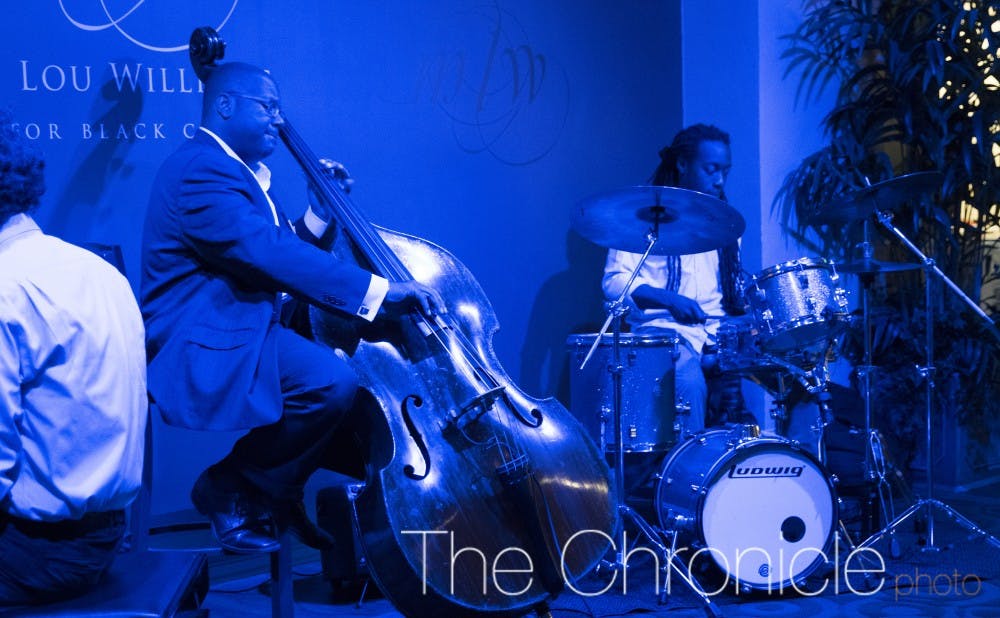Riley Mangan works at the Human Vaccine Institute on mother-to-child transmissions of HIV. Modestly dressed in a plain sweater and jeans, he speaks with a smart, youthful earnestness; the phrase “boyish charm” was invented for guys like him. But he can’t talk for long. It is Wednesday at the Mary Lou Williams Center for Black Culture, and tonight he’s the new guy on piano.
Mangan goes about his business methodically. His lean frame is hunched over, and his deliberate phrasing is complemented by crisp, clean tones. Hearing his careful silences, one thinks: this is a man who think things through. But he also delights in dense arpeggios that run the length of the keyboard, and when the moment seizes him, which is often, he bounces his left foot so vigorously it is almost a stomp.
“One of the best things about a jam session is the strangers. You get somebody who is rolling through, maybe they’re playing with a show that’s touring and they’re going to be in Durham for two weeks,” Mangan said. “You get somebody coming up on stage, has his horns and about to take solo—no idea what this guy sounds like. Sometimes they’re just okay, and other times they knock the socks off your feet.”
True, Jazz at the Mary Lou has its recurring figures: its founder and director of Duke’s jazz program Professor John Brown, and his many friends of regional fame (like saxophonist Brian Miller, trumpetist Al Strong). But more often than not, you can observe musicians of all stripes—sometimes so outwardly dissimilar it’s comical—jam in awesome creative communion, and afterwards they will shake hands, and you realize: they’ve just met.
In the subterranean dimness, laptops glow; most audience members are working, but nobody takes offense. Drummer Donovan Cheatham and pianist Andrew Berinson are members of the house band, and they have a palpable bromance that likely resulted from four years of collaboration which started during their time at North Carolina Central University. Berinson plays with a wistful lightness of touch; Cheatham’s technical prowess dominates. But they are just as interested in having a conversation with you as they are with each other.
“Most of the people in the audience aren’t musicians, which to me is a good thing,” Berinson said. “Music is a social art, so it’s meant to be shared. They could be studying in their room or the library or a coffee shop, but they came here to hear some jazz.”
“There’s audience and then there’s us, and if there’s energy coming from both directions, that kinda makes the world go round,” Cheatham said.
Sitting at the back row, awash in soulful melodies, Ingrid Lorese is a bit restless. Born in the Philippines and raised in the States, she grew up surrounded by rhythm and voice. Her father was a pastor who directed the church choir, so she ended up singing worship music a lot. Her childhood hero was Filipina Broadway star Lea Salonga. Since coming to Duke, she has joined an a capella group and the Duke Jazz Ensemble.
And yet, she’s nervous about singing tonight. Lorese, a senior, has sat in the Mary Lou crowd since she was a sophomore. For two full years she did not consider performing. While the event is technically an open jam session, it has a guarantee on quality. Ask any jazz musician in the Triangle area, and absolutely nobody talks smack about the Mary Lou. This is to the credit of Brown’s discerning eye (and ear): his signature invitation goes, “We welcome all—and listen closely—qualified musicians.”
Many student musicians admit that performing at the Mary Lou is intimidating. Jazz combo sets can be competitive, and the technical challenges of improvisation demand training and trust, both in others and in yourself. But Lorese had been watching, learning and making friends with fellow artists. Growth takes time, but now the time is right.
“The only thing that really finally convinced me to try was realizing I was a senior and there was no point in being scared anymore,” she said.
The first song she ever sang at the Mary Lou was one of her favorites, “The Way You Look Tonight.” Now she sings “The Nearness of You.” Propelled by the thick sweep of the bass line, she sways, reaching for and holding the richness in every word. She loves how Ella Fitzgerald sang this song.
I need no soft lights to enchant me / If you'll only grant me the right to hold you ever so tight / And to feel in the night the nearness of you.
Perhaps next week Lorese, Mangan, and other familiar faces will return. Perhaps they won’t, and instead we’ll see strangers telling new stories in music, of how they feel, how their day is like, their hopes, fears, dreams. That’s a regular Wednesday evening at the Mary Lou for you.
As Whitney Balliett once wrote: what is jazz? Jazz is the sound of surprise.
Jazz at the Mary Lou is hosted at the Mary Lou Williams Center for Black Culture every Wednesday from 9:30 pm to 12:30 am. Admission is free.
Get The Chronicle straight to your inbox
Signup for our weekly newsletter. Cancel at any time.

